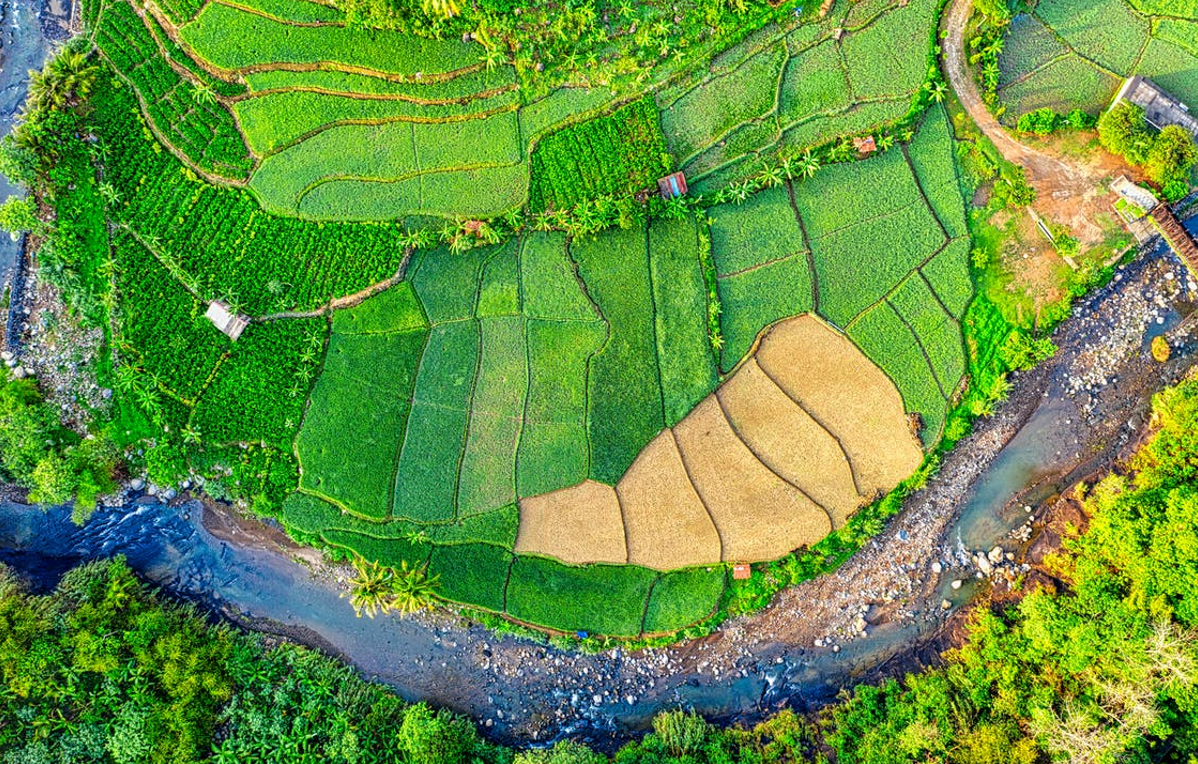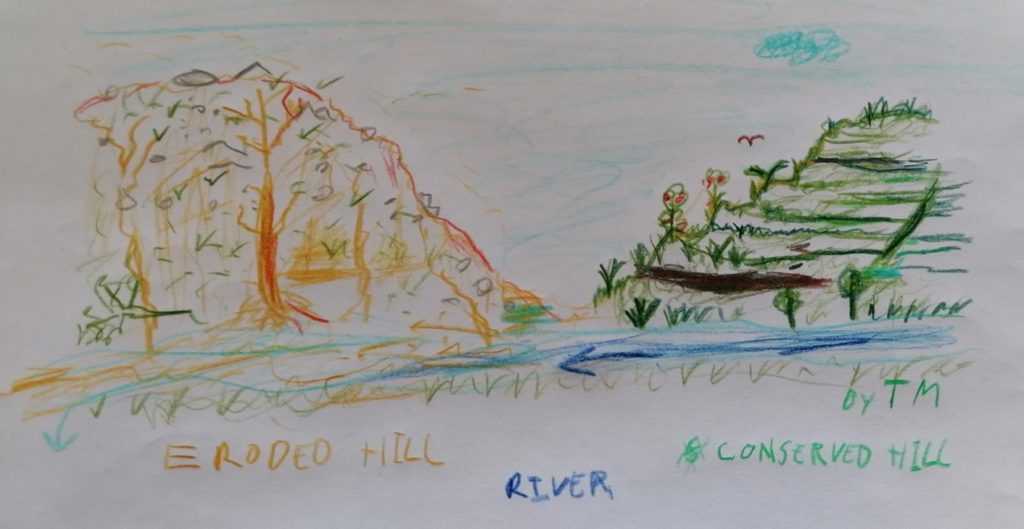Soil and Water Conservation Strategies

This post is also available in:
This post is also available in:
![]() Français (French)
Français (French) ![]() Deutsch (German)
Deutsch (German) ![]() हिन्दी (Hindi)
हिन्दी (Hindi) ![]() العربية (Arabic)
العربية (Arabic) ![]() Türkçe (Turkish)
Türkçe (Turkish) ![]() 简体中文 (Chinese (Simplified))
简体中文 (Chinese (Simplified)) ![]() Português (Portuguese (Brazil))
Português (Portuguese (Brazil))
Several practical principles for soil and water conservations are important to be understood and combined – including how to use them so they help rather than harm and give multiple benefits at a limited cost in time.
Plant and soil cover near the surface can help soil and water conservation, but trees can help and harm cultivated land.
Low or slowly established vegetation cover after land preparation exposes the soil to wind and raindrops at least at the start of the cropping season. See Figure 1 below. Poor plant cover can be due to intensive tillage (soil disturbance), cultivation and planting methods, and/or due to soil depletion of nutrients and soil organic matter. Some will confusingly blame “intensive” and some blame “extensive farming, but it should depend on what is intensified and how. Slow plant growth and some cultivation methods and crops cause a decrease in soil organic matter and surface cover. Mineral fertilizers can make plants grow faster, but sometimes they are used to replace other soil conserving and improving methods like intercropping and fallow farming with plant cover.
Cover near the soil surface matters. Protection against rain drops at or just above the soil surface is very important. A cover at or a bit above the ground can effectively protect the soil structure from raindrops and prevent erosion. E.g., a good cover of beans or other cover crops works. In an old field experiment in Africa using a 20-cm raised mosquito net was effective; it was used for studying the effect of cover alone, not as a practical method. In a natural forest, the soil surface will usually be covered well. However, raindrops join on leaves and drop with more acceleration and movement energy per square meter from tall crops or trees. It has been well-documented for decades but not well-known.
Organic matter and dead plant parts on the surface (litter) help stabilize soil structure in aggregates so water can enter pores, help the soil stay in place, and absorb water. Deep roots and the pores they leave when rotten in uncompacted soil also help water enter quickly deeper into the ground. Roots near the surface can assist too by stabilizing soil structure (aggregates) and keeping pores open for water to enter. A cover of leaves, stones, or dead materials near the surface can protect the topsoil. Suitable contour belts or field boundaries across the slope can sometimes be enough. See the Figure 1 below.

Figure 1. Principles for soil and water conservation (by Torsten Mandal)
Figure 1. Without soil and water conservation (left) a cultivated or overgrazed hill can develop exposed rocks (grey), rill and gully erosion (yellow), poor vegetation growth (green), and polluted water (yellow-blue). The yellowish soil is low in organic matter. The conserved hill (right) has high vegetation cover with healthy colour (dark green), terraces and waterways with permanent crop cover, and clean, steady water flows (blue). The vegetation contributes to biodiversity and cloud formation in the landscape. By Torsten Mandal 2022.
Roots and decaying organic materials also help maintain a good, stable soil structure by forming fungal hyphae (threats that are hard to see) and sticky liquids. Deep strong roots can also help keep soil layers together against slides. Sometimes roots (e.g., of some mat-forming grasses) can slow water flows. However, some roots have little or no effect because they extend below the topsoil. If the unprotected aggregated soil parts have been dispersed in water, it may be too late for roots to hold it back. Also, some bigger roots on the surface can lead water to form concentrated, faster, and more erosive flows in areas where the root can no longer hold back water.
RUSLE-soil loss estimates. Soil erosion caused by water is often estimated today by the Revised Universal Soil Loss Equation (RUSLE). A yearly loss of more than 10 tons per hectare (1 kg/m2) is generally considered significant and unsustainable. RUSLE is a replacement for the similar “USLE” and, e.g., differs in the type of rain considered relevant, including protection from stones and sedimentation within fields. The use of locally relevant data is an important challenge for model uses. An example of the use from western Kenya was published in 2021, including an illustrated overview with experiences of conservation measures (Watene and co-workers, 2021).
Soil conservation strategies are explained in more detail after this introduction.
- Soil conservation structures: Fences, shelterbelts, windbreaks, permanent conservation lines, terraces, cut-off drains, gully repair, etc.
Fields are particularly eroded before plants cover them, so it is essential to have some kind of permanent structures against erosion – but plants can help form them.
Structures for soil and water conservation can be fences, terraces, water harvesting, cut-off drains, and gully repair. These structures can stop or slow down wind or water flows and erosion, and they can be needed in some areas. Some water conservation structures also help collect water for use in pipes or buckets. Risks include water accumulating, breaking through, or passing around massive obstacles with increased speed and erosive force. These can cause more erosion, e.g., if structures are not well constructed, protected with long-lasting vegetation, and maintained. Also, the investment of work, land, money, and expertise can be considerable. Increased erosion may occur between or around poorly created structures if flow rates increase. Several solutions are explained in the detailed section. Combinations with other methods are also necessary, as well as local adaptation.
- Tillage incl. minimum tillage and zero tillage, conservation tillage, chiselling, ripping, harrowing, mouldboard, or disc ploughing: Cultivation can help or harm
Hoeing, digging, ploughing, harrowing, ridging, chiselling, and ripening are all tillage. Tillage can decrease or sometimes increase soil and water conservation.
The Benefits of tillage for soil conservation can include:
- making compact flat surfaces more open for water entry and rough,
- contour tillage across the slope or wind direction reducing flow rates, e.g., with contour ridges that are tied, so water is not accumulating and starting rill erosion.
- deep chiselling or ripping so water and roots can enter the subsoil.
- reduce the need for burning crop residues, cutting under cover crops when needed for the main crops.
- conserving water by reducing plant growth in areas like belts or periods.
The Disadvantages include:
- pulverizing soil aggregates reduces coherence and water infiltration.
- breaking down organic matter by oxidation by breaking soil clods.
- turning under plants and crop residues, e.g., by ploughing.
- damaging some of the soil organisms at least temporarily,
- compacting too moist clay soil layers with tires of heavy tractors used for tillage.
- removing trees and shrubs to access tractors or livestock tillage.
- drivers can prefer driving up and down slopes for their safety and comfort, but it causes erosion.
- no- or reduced tillage strategies require keeping the soil covered with plants and litter, but as mentioned in the following sections, several principles can be used.
Crop establishment and growth, cover crops, and plant cover
Establishing plants that permanently or at least early in the growing season protect the soil is important for soil conservation, including water infiltration. It can help establish high populations, rows across the wind or slope direction, suitable ridging in these directions, species that can be established early or even in the preceding season, and species and conditions giving rapid early growth and cover near the ground.
Cover crops can be used to improve and protect the soil, retain nutrients, add organic matter, etc. They may be selected so they die before establishing the main crop, undercut, and/or, e.g., seeded when weeding it.
Stones on the surface also protect against erosion – but be an indicator of erosion. Stone lines across the slopes can help, too, if water flows are slowed rather than concentrated.
Intercropping
Intercropping can increase the plant cover of the soil by the overlap between crops when they are on the same land or in lines beside each other. Intercropping often gives more effective land use because of differences in crop timing, height, roots, soil nutrient requirements, pests, diseases, etc.
Agroforestry
Agroforestry (trees on farms) can particularly help either
A) as windbreaks or shelterbelts across the contour hedges across slope but too dense hedges stopping abruptly can cause increased wind speeds around, below or some distance behind them or
B) as contour hedges with permanent cover at and near the soil surface while the tops can be kept with few leaves in the growing season of the crops. Trees without a cover on or near the soil may increase erosion because drops join on leaves and fall faster.
Integrated watershed management
Integrated watershed management approaches consider a river’s catchment area and landscapes with many uses, purposes, and interests. Steep slopes with shallow soils may, e.g., be best covered with trees or managed pasture. Downstream areas may pay for ecosystem services like soil and water conservation. Local people and organizations should be included in modern mapping and model planning.
Improved low-input agroforestry and methods
Improved low-input establishment methods of a plant can help fit soil conserving plants in between other plants and into short-term priorities and shortage of money, labour, land, and transport. They can promote fast germination and early growth, at least for tree legumes at challenging sites. Improved management can help get good cover near the ground. Mandal (2010) provides details and references.
Water conservation
Water conservation within the fields (“în-situ” is part of all the points above, even if competition among plants also is important). Water conservation also includes:
- Collecting liquid water in structures.
- Recycling wastewater.
- Minimizing the need for irrigation and other water uses.
References
Baumhardt RL, and Blanco-Canqui H 2014 Soil: Conservation Practices. In: Neal Van Alfen, editor-in-chief. Encyclopedia of Agriculture and Food Systems 5, Elsevier, 153-165.
Hudson W N 1987 Soil and water conservation in semi-arid areas. Silsoe Associates Ampthill, Bedford United Kingdom. Soil Resources, Management and Conservation Service. FAO Land and Water Development Division. Food and Agriculture Organization of the United Nations Rome, 1987 https://www.fao.org/3/t0321e/t0321e00.htm
FAO, seen 2022, Revised Universal Soil Loss Equation. https://www.fao.org/land-water/land/land-governance/land-resources-planning-toolbox/category/details/en/c/1236444
Land and Water Division 2000 Manual on Integrated Soil Management and Conservation Practices. FAO land and water bulletin Series number: 1024-6703. 214 pp. ISBN: 9251044171 https://www.fao.org/publications/card/en/c/31f117c4-13e2-5631-bf16-ebaaa10b714f
Luna et al. 2000. The role of olive trees in rainfall erosivity and runoff and sediment yield in the soil beneath. Hydrology and Earth Sciences 4, 141-153. https://hess.copernicus.org/articles/4/141/2000/hess-4-141-2000.pdf
Muriuki JP, Macharia PN 2011 Green Water Credits Report K12: Inventory and Analysis of Existing Soil and Water Conservation Practices in Upper Tana, Kenya. https://www.isric.org/documents/document-type/green-water-credits-report-k12-inventory-and-analysis-existing-soil-and Open access.
Mandal T. 2010. Low-cost soil and water conservation with many early benefits. Presentation Researchers’ Day: Climate Change Impact, Adaptation and Mitigation GEUS, Inst. of Geography, University of Copenhagen. 7 October 2010. Arranged by the Climate Change Task Force. https://www.yumpu.com/en/document/view/35209735/present-danish-water-forum
Thomas DB et al. 1997. Soil and water conservation manual. Soil and Water Conservation Branch, Min. Agric. Livestock Dev. and Marketing, Nairobi Kenya.
Watene G and others 2021 Water Erosion Risk Assessment in the Kenya Great Rift Valley Region Sustainability 2021, 13(2), 844; https://doi.org/10.3390/su13020844
Yoshinori et al. 2018 Factors influencing the erosivity indices of raindrops in Japanese cypress plantations. Catena 171, 54-61, December 2018, DOI:10.1016/j.catena.2018.06.030 http://www.ffpri.affrc.go.jp/ffpri/en/research/results/2018/20180910-06.html








































































